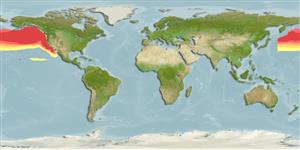>
Aulopiformes (Grinners) >
Scopelarchidae (Pearleyes)
Etymology: Benthalbella: A possible interpretation is related to Greek, benthos = the deep sea + Latin, albus = white; but it is need more information; dentata: dentatus meaning toothed - referring to the unusual arrangement of prominent teeth (Ref. 6885).
Environment: milieu / climate zone / depth range / distribution range
Ökologie
seewasser bathypelagisch; tiefenbereich 98 - 3400 m (Ref. 50550), usually 500 - 1000 m (Ref. 2850). Deep-water; 58°N - 14°N, 153°E - 110°W
Northeast Pacific: Gulf of Alaska to Baja California, Mexico. Northwest Pacific: Japan and the Sea of Okhotsk.
Size / Gewicht / Alter
Maturity: Lm ? range ? - ? cm
Max length : 26.2 cm TL Männchen/unbestimmt; (Ref. 80637)
Kurzbeschreibung
Morphologie | Morphometrie
Rückenflossenstacheln (insgesamt): 0; Rückenflossenweichstrahlen (insgesamt): 6-8; Afterflossenstacheln 0; Afterflossenweichstrahlen: 17 - 21; Wirbelzahl: 54 - 55. Adipose very slender; pectorals small; pelvic fins large and expanded (Ref. 6885). Brown dorsally, lighter below (Ref. 6885). Brown dorsally, lighter below (Ref. 6885). Branchiostegal rays: 8 (Ref. 35929).
Synchronous hermaphrodites (Ref. 35929). Oviparous, with planktonic larvae (Ref. 35929).
Life cycle and mating behavior
Geschlechtsreife | Fortpflanzung | Ablaichen | Eier | Fecundity | Larven
Eschmeyer, W.N., E.S. Herald and H. Hammann, 1983. A field guide to Pacific coast fishes of North America. Boston (MA, USA): Houghton Mifflin Company. xii+336 p. (Ref. 2850)
IUCN Rote Liste Status (Ref. 130435)
Bedrohung für Menschen
Harmless
Nutzung durch Menschen
Mehr Information
ReferenzenAquakulturAquakultur ProfilZuchtlinienGenetikElectrophoresesVererbbarkeitKrankheitenVerarbeitungNutrientsMass conversion
PartnerBilderStamps, Coins Misc.LauteCiguateraGeschwindigkeitSchwimmstilKiemenoberflächeOtolithsGehirngrößeSehfähigkeit
Tools
Zusatzinformationen
Download XML
Internet Quellen
Estimates based on models
Preferred temperature (Ref.
123201): 2.2 - 5.3, mean 3.3 °C (based on 86 cells).
Phylogenetic diversity index (Ref.
82804): PD
50 = 0.5313 [Uniqueness, from 0.5 = low to 2.0 = high].
Bayesian length-weight: a=0.00347 (0.00144 - 0.00836), b=3.15 (2.94 - 3.36), in cm total length, based on LWR estimates for this (Sub)family-body shape (Ref.
93245).
Trophic level (Ref.
69278): 4.5 ±0.80 se; based on food items.
Fishing Vulnerability (Ref.
59153): Low vulnerability (16 of 100).
